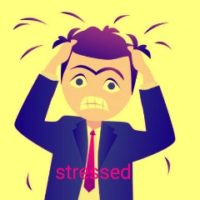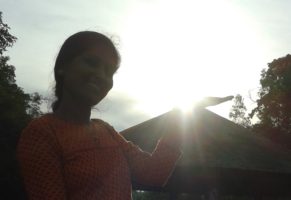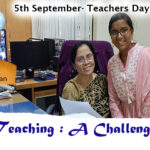Ayurveda for a stress-free childhood

- When was the last time you had a good laugh with your children?? Playing their favourite game, forgetting all your pending works, meetings and deadlines?
- Is your child having any recreational activity every day? Or are they hyper scheduled with school, tuition and coaching classes not getting enough time to inculcate their passion?
- Is stress playing a bigger role in your kid’s life than you imagined it to be?
For most of us, the answer to this question is a resounding “YES”. Stress is the greatest threat in today’s era affecting mostly the urban population, distressing the adults and children equally.
More often then we intend to, we find it difficult to give time for our children and family. Meeting the deadlines, keeping up with the schedule, keeps us on our toes rendering us demanding.
With the examination flu in the air, stress is taking away the happiness from the children and with that their productivity.
Stress starts in the child from the moment they wake up to school, to make it on time for their classes, to get the calculations right, to ace in exams, for choosing the right career when they grow up etc.
Sometimes we consciously overlook the stress of our children in their path to excellence. It could be because we too are in the virtual rat race. When the parents are stressed out it reflects on the kids as well.
With the growing need for the future minds to ace in their subject of interest, more responsibilities lie on the shoulders of parents. For which it is utmost important that primarily the parents are keeping their inner peace. Through this article an attempt is made to share few health tips advises and lifestyle correction to parents to follow and instill in their children for a stress-free life.
Too much stress compromises our health physically, mentally and emotionally causing a plethora of symptoms like anxiety, anger, fatigue, headache, depression, insomnia.
Luckily for us, our Indian medical science has answers to all these maladies. Ayurveda shines in its capacity to distill a host of complex ailments into three basic bio elements called the ‘doshas’. This distinction helps to illuminate the path towards healing for everyone.
Ayurveda at home
Ayurveda offers a beautiful perspective for combating the stress in children. It starts with the time they wake up
Brahma muhurthauttishte.


It is said that the best time to wake up is in the brahma muhurtha which is from 3-am to 6-am. This is the best time to acquire “brahma” (knowledge). Researchers also agree that human brain cells tend to be more receptive during early part of the dawn. Fresh morning air helps to bring the mind in the positive frame, resulting in stress free study.
Yoga
The practice of yoga involves stretching the body and forming different poses, while keeping breathing slow and controlled. There are multiple ways that yoga can minimise the stress levels. Studies show that the most effective way in which yoga targets stress is by lifting one’s mood and bringing positivity; simultaneously getting us into better moods, enabling us to be more focused on the present moment. Yoga has psychological and spiritual benefits. It is a very effective stress reliever; it improves concentration to deal with situations with a calm mind. It also helps to maintain body fitness and increases the immunity. Practice of yoga from childhood is going to benefit the child on the long run.
Pranayama
“Breathing the prana ”PRANAYAMA
Haven’t we all thought of a dream vacation? To escape into the woods or a hill station, probably even a beach!
What most of us do not realize is that we have an effective inexpensive and safe remedy for anxiety and stress right in their hands. It is our Breath!!!
PRANAYAMA consists of two words, prana breath, ayama extension. It simply means extension of breath and thus the life through breath. Taking the attention to the breath can help free the mind of unnecessary clutter of thoughts that breed anxiety.
The other regimes mentioned in this article for de-stressing requires practice for a long term, but pranayama is the only one which gives instantaneous effect. There are different types of pranayama like the nadishuddhipranayama, sheetali, sheetakari and brahmari. Among these, brahmari benefits a lot for anxiety. Brahmari, when practised immediately alleviates anger, anxiety and helps for self-healing. The vibration of the humming sound creates a soothing effect on the mind and nervous system. You can get started right now.
To practice the Brahmari Pranayama just follow these simple steps:
1. Sit in a comfortable meditation asana, preferably padmasana or siddha asana (sitting on the ground with folded legs) with hands resting on the knees in chin mudra(index finger tucked under thumb, other three fingers extended and palm facing upwards)
2. Close the eyes and relax the whole body.
3. The lips should remain gently closed with the teeth slightly separated throughout the practice. This allows the sound vibration to be heard and felt more distinctly.
4. Raise the arms sideways and bend the elbows, bringing the hands to the ears. Use the thumb finger to plug the ears or the flaps of the ears may be pressed without inserting the fingers.
5. Cover the eyes with remaining four fingers.
6. Bring awareness to the centre of the head, where ajna chakra is located, and keep the body still. Inhale through the nose.
7. Exhale slowly and in a controlled manner while making a deep, steady humming sound like a bee. The humming should be smooth, even and continuous for the duration of the exhalation. The sound should be soft and mellow, making the front of the skull reverberate. At the end of exhalation, the hands can be kept steady or returned to the knee and then raised again for the next round.
This is brahmari pranayama which leaves one totally mesmerised by its effect. Meditation is also an incredibly powerful tool for relaxing and slowing down the mind. But it is too much to ask the child to do meditation. Adults can follow it for relaxation.
Abyanga
Application of oil and self-massage is the best way to remove the tension. It relaxes the mind and body, relieves stress meanwhile nourishing the skin and hair. Abyanga should be resorted to daily. It wards off old age, exertion, bestows good vision and promotes good sleep. Parents or grand-parents can help younger children with abyanga. Older kids and teenagers can be trained how to self-massage before bathing.
Snana
Taking bath gives an instant zeal. It removes the tiredness from body and mind. It is rejuvenating and should be indulged every day. Whenever stressed, a bath again relaxes the nervous system, release tension and calms the mind.
Padabyanga
Padabyanga is massaging the feet and legs with medicated Sneha (oil or ghee) focusing on the reflex points. Massage to the foot calms the mind, relaxes and revitalises the body. It removes fatigue, promotes sleep and one of the best remedy for stress. Massaging the foot before bed gives the desired effects. Padabyanga can be done by self in older kids once trained, in young children parents can help in the massage.


Dr. Chaitra.S
Associate Professor (Kayachikitsa)
SDM Institute of Ayurveda and Hospital,
Bengaluru
Ph: 8971-564-998
Email:ayur.chytra@gmail.com











